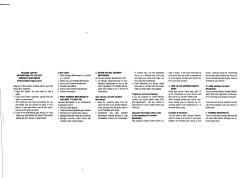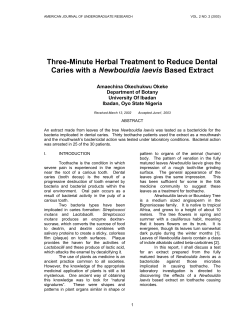
Magic Mouthwash PHARMACIST’S LETTER / PRESCRIBER’S LETTER
Detail-Document #230703 −This Detail-Document accompanies the related article published in− PHARMACIST’S LETTER / PRESCRIBER’S LETTER July 2007 ~ Volume 23 ~ Number 230703 Magic Mouthwash There are numerous magic mouthwash formulations. Most contain at least three ingredients. Formulas may contain a combination of an antibiotic (to reduce the bacterial flora around the lesion), antihistamine (for local anesthetic effect), antifungal (to stop any fungal growth), steroid (to reduce inflammation), a local anesthetic/pain reliever, or an antacid (to enhance coating of the ingredients on the mouth).1 Most of the formulations are used every four to six hours with instructions to hold in the mouth for one to two minutes then spit out or swallow. Patients should be instructed to shake the bottle well before using and not to eat or drink for 30 minutes after use.1 Below is a list of commonly used magic mouthwash formulas (instructions given if available): Ingredientsa-e,g Amount Diphenhydramine 12.5 mg/5 mL 240 mL Hydrocortisone 60 mg Nystatin powder 6 million units Tetracycline 1.5 g Swish and spit 5 mL QID a.k.a. Mary’s Magic Potion Distilled water 160 mL Hydrocortisone 80 mg Maalox 80 mL Swish and spit 5 mL QID a.k.a. Weisman’s Philadelphia Mouthwash Diphenhydramine 12.5 mg/5 mL 1 part Nystatin suspension 1 part Maalox 1 part Water 1 part Diphenhydramine 12.5 mg/5 mL 1 part Viscous lidocaine 2% 1 part Maalox 1 part Swish and swallow 5 mL no more than Q 4 H Diphenhydramine 12.5 mg/5 mL 240 mL 120 mg Hydrocortisone powder f (wet with 1% CMC to dissolve) Nystatin Suspension 60 mL Tetracycline 125 mg/5 mL 120 mL (capsule dissolved in flavored syrup) CMCf 1% QS to 480 mL Swish and swallow 10 mL TID Ingredientsa-e,g Amount Diphenhydramine 12.5 mg/5 mL 30 mL Mylanta or Maalox 60 mL Sucralfate 4g Hydrocortisone 60 mg Nystatin Suspension 30 mL OR Powder 3 million units Diphenhydramine 12.5 mg/5 mL QS to 240 mL a.k.a. Duke’s Magic Mouthwash Diphenhydramine 12.5 mg/5 mL 180 mL Hydrocortisone 0.072 g Nystatin suspension 36 mL Tetracycline 0.75 g Diphenhydramine 12.5 mg/5 mL Hydrocortisone Nystatin suspension Tetracycline 100 mL 0.02 g 4.8 mL 200 mg Diphenhydramine 12.5 mg/5 mL Prednisone 5 mg/5 mL Nystatin suspension 1 part 1 part 1 part More. . . Copyright © 2007 by Therapeutic Research Center Pharmacist’s Letter / Prescriber’s Letter ~ P.O. Box 8190, Stockton, CA 95208 ~ Phone: 209-472-2240 ~ Fax: 209-472-2249 www.pharmacistsletter.com ~ www.prescribersletter.com (Detail-Document #230703: Page 2 of 5) Ingredientsa-e Diphenhydramine 12.5 mg/5 mL Prednisone 5 mg/5 mL Nystatin suspension Amount 1 part 1 part 1 part Cherry flavored Kool-Aid mixed 100 mL with 2000 mL distilled water (sugar-free) Viscous lidocaine 2% 100 mL Nystatin suspension 100 mL Swish and spit or swallow 15 mL QID a.k.a. Koolstat Hydrocortisone 100 mg/2 mL 12 mL (Solu-Cortef) Nystatin suspension 7.2 mL Tetracycline 125 mg/5 mL 12 mL (capsule dissolved in syrup) Diphenhydramine 12.5 mg /mL 150 mL Swish and swallow 10 mL QID Viscous lidocaine 2% Hydrocortisone 100 mg/2 mL (Solu-Cortef) Nystatin suspension Mouth rinse Do not swallow 250 mL 1g 150 mL QS 500 mL Diphenhydramine 12.5 mg /5 mL Dexamethasone 4 mg/mL injection Nystatin suspension Distilled water Swish and Spit 5 mL QID 120 mL 0.56 mL 40 mL 39 mL Viscous lidocaine 2% Cherry flavored Kool-Aid mixed with 1500 mL of sterile water for irrigation (sugar-free) 2000 mL QS 3400 mL Viscous lidocaine 2% 150 mL Diphenhydramine 12.5 mg/5 mL 20 mL Hydrocortisone (Solu-Cortef) 100 mg Tetracycline 2 grams Nystatin suspension 20 mL Swish and swallow 15 to 30 mL Q4-6H a.k.a. Mile’s Solution a. Elixirs containing alcohol can cause stinging. Consider using injectable or powder formulation, crushing tablets, or opening capsules in place of elixir formulation to avoid stinging. b. Some U.S. clinicians have found the new formulation of Kaopectate (i.e., containing bismuth) to solidify over a short period of time when mixed with other ingredients. U.S. clinicians should consider this potential problem if utilizing recipes which use Kaopectate in the place of Maalox. Canadian Kaopectate formulation does not contain bismuth. c. Nystatin has not been shown to be effective in treating oral fungal infection associated with oral mucositis.1 d. The use of corticosteroids, such as hydrocortisone or dexamethasone, has not been adequately studied to recommend its inclusion in magic mouth.1 e. Some suggest that if a mixture contains water, the expiration should not be longer than two weeks.1 f. CMC= Carboxymethylcellulose. g. Some of the formulations listed are, or will soon be, available as ready-to-mix kits by CutisPharma (www.cutispharma.com). Users of this document are cautioned to use their own professional judgment and consult any other necessary or appropriate sources prior to making clinical judgments based on the content of this document. Our editors have researched the information with input from experts, government agencies, and national organizations. Information and Internet links in this article were current as of the date of publication. More. . . Copyright © 2007 by Therapeutic Research Center Pharmacist’s Letter / Prescriber’s Letter ~ P.O. Box 8190, Stockton, CA 95208 Phone: 209-472-2240 ~ Fax: 209-472-2249 www.pharmacistsletter.com ~ www.prescribersletter.com (Detail-Document #230703: Page 3 of 5) Sources used for recipes include the following: • • • • • • • • • The Erie St. Clair Palliative Care Management Tool. January 2007. http://ccacont.ca/Upload/esc/General/Palliative__C are_Managment_Tool_v3_1.pdf. (Accessed June 19, 2007). Anon. Slang terms and jargon can cause medication errors. Drugs & Therapy Bulletin. Shands at the University of Florida. November/December 2005. Volume 19, Number 10. http://www.shands.org/professionals/dru gInfo/bulletins/1005.pdf. (Accessed June 19, 2007). Bulletin Board of Oral Pathology. University at Buffalo. http://listserv.buffalo.edu/cgibin/wa?A2=ind0704&L=bboplist&T=0 &P=11645--. (Accessed June 19, 2007). North Carolina Board of Pharmacy. http://www.ncbop.org/faqs/Pharmacist/f aq_DukesMagicMouthwash.htm. (Accessed June 19, 2007). Hodgins C, Mosley M, Pola-Strowd M. Recommendations for the diagnosis and management of recurrent aphthous stomatitis. National Guideline Clearinghouse. http://www.guideline.gov/summary/sum mary.aspx?ss=15&doc_id=4368&nbr=3 290. (Accessed June 19, 2007). Tarascon Pocket Pharmacopoeia. 2007 Deluxe Lab-coat Edition. www.tarascon.com. Department of Pharmacy Services. Mount Sinai Hospital. Toronto, Ontario MSG 1XS. Toronto Sunnybrook Regional Cancer Centre Pharmacy. Toronto, Ontario M4N 3M5. Drug Information and Research Centre. Ontario Pharmacist’s Association. More. . . Copyright © 2007 by Therapeutic Research Center Pharmacist’s Letter / Prescriber’s Letter ~ P.O. Box 8190, Stockton, CA 95208 Phone: 209-472-2240 ~ Fax: 209-472-2249 www.pharmacistsletter.com ~ www.prescribersletter.com (Detail-Document #230703: Page 4 of 5) Magic Mouthwash Background “Magic mouthwash” is commonly prescribed for conditions such as chemotherapy/radiationinduced mucositis, canker sores, mouth pain, etc. The logic behind magic mouthwash is to combine ingredients with different potential mechanisms of action to treat a variety of oral conditions. There is not a standard formulation for magic mouthwash and problems can arise when patients receive a product different from what the prescriber intended. There is also a potential for allergic reaction to one of the ingredients if the formulation dispensed is not intended by the prescriber. Although there is no evidence that magic mouthwashes are effective, different formulations of magic mouthwash continue to be prescribed. This document provides a list of common magic mouthwash formulations and the rationale for each ingredient used. Formulations There are numerous magic mouthwash formulations. Most contain at least three ingredients. Concoctions may contain a combination of an antibiotic (to reduce the bacterial flora around the lesion), antihistamine (for local anesthetic effect), antifungal (to stop any fungal growth), steroid (to reduce inflammation), a local anesthetic/pain reliever, or an antacid (to enhance coating of the ingredients on the mouth).1 The most popular formulation includes topical anesthetics such as lidocaine viscous and diphenhydramine plus Maalox (aluminum/ magnesium hydroxide) to enhance coating of the ingredients in the mouth. Other formulations include antifungals, corticosteroids, or antibiotics for infections or inflammations.1,2 Most of the formulations are used every four to six hours with instructions to hold in the mouth for one to two minutes then spit out or swallow. Patients should be instructed not to eat or drink for 30 minutes after use.1 When compounding these mixtures, try to avoid using elixir formulations as the alcohol contents can cause stinging. Consider injectable or bulk powder formulations, crushed tablets, or opened capsules if needed. In some cases injectable formulations are used in place of elixirs. Some U.S. clinicians have found the new formulation of Kaopectate (i.e., containing bismuth) to solidify over a short period of time when mixed with other ingredients. U.S. clinicians should consider this potential problem if utilizing recipes which use Kaopectate in the place of Maalox. Canadian Kaopectate formulation does not contain bismuth. Expiration of these mixtures vary depending on the ingredients. Some suggest that if a mixture contains water, the expiration should not be longer than two weeks.1 Aside from magic mouthwash, single agents such as chlorhexidine oral rinse (Peridex) and sucralfate (Carafate) suspension have also been tried for chemotherapy/radiation-induced oral mucositis.4 Efficacy There is a lack of controlled studies to evaluate the efficacy of the many different magic mouthwash recipes. Whether one recipe is more effective than another is unknown. There is only one study comparing the efficacy of magic mouthwash (diphenhydramine, viscous lidocaine, Maalox) to other agents such as chlorhexidine (Peridex) and saline/baking soda solution. In this randomized, double-blind study (n=200), patients with mucositis were followed from the time they developed mucositis until the signs and symptoms of mucositis subsided or until they finished their 12-day supply of mouthwash.2 Patients were taught how to assess their own mouths and were followed by phone interviews for updates on the signs and symptoms of mucositis. At the end of the study, there was no difference in efficacy among the different mouthwashes.2 The current guidelines for the treatment of oral mucositis suggest that compounded magic mouthwashes (with various combinations of viscous lidocaine, benzocaine, milk of magnesia, kaolin-pectin, chlorhexidine, or diphenhydramine) are no better than normal saline solution in pain In relief [Evidence level C; Consensus].3 addition, a Cochrane review found magic mouthwash (containing lidocaine, diphenhydramine, and aluminum hydroxide) to be ineffective in shortening the healing time of oral More. . . Copyright © 2007 by Therapeutic Research Center Pharmacist’s Letter / Prescriber’s Letter ~ P.O. Box 8190, Stockton, CA 95208 ~ Phone: 209-472-2240 ~ Fax: 209-472-2249 www.pharmacistsletter.com ~ www.prescribersletter.com (Detail-Document #230703: Page 5 of 5) mucositis related to cancer therapies.4 There is also concern about the absorption of anesthetics such as lidocaine when used on damaged mucosa.3 Although frequently used as ingredients of magic mouthwash, nystatin has not been shown to be effective in treating oral fungal infection associated with mucositis.1 Some also suggest that the high sugar content of nystatin suspension may feed the fungus.2 Corticosteroids have not been studied adequately to be recommended as an ingredient of magic mouthwash and there’s concern that long-term use may lead to oral candidiasis. Levels of Evidence In accordance with the trend towards Evidence-Based Medicine, we are citing the LEVEL OF EVIDENCE for the statements we publish. Level A B C Conclusion D Despite the lack of evidence that magic mouthwashes work in decreasing the pain associated with chemotherapy/radiation-induced mucositis, canker sores, or other oral pain conditions, many patients and prescribers continue to use them. There is a need to standardize the ingredients used to compound magic mouthwash in order to fully evaluate its efficacy. Prior to dispensing magic mouthwash, pharmacists should verify the formula and patient allergies. Patient should be counseled regarding the proper use of magic mouthwash (e.g., to shake well before use, hold in mouth for a minute or two, whether to swallow or not, etc). Users of this document are cautioned to use their own professional judgment and consult any other necessary or appropriate sources prior to making clinical judgments based on the content of this document. Our editors have researched the information with input from experts, government agencies, and national organizations. Information and Internet links in this article were current as of the date of publication. Cite this Detail-Document as follows: 2007;23(7):230703. Definition High-quality randomized controlled trial (RCT) High-quality meta-analysis (quantitative systematic review) Nonrandomized clinical trial Nonquantitative systematic review Lower quality RCT Clinical cohort study Case-control study Historical control Epidemiologic study Consensus Expert opinion Anecdotal evidence In vitro or animal study Adapted from Siwek J, et al. How to write an evidence-based clinical review article. Am Fam Physician 2002;65:251-8. Project Leader in preparation of this DetailDocument: Wan-Chih Tom, Pharm.D. References 1. 2. 3. 4. Chan A, Ignoffo RJ. Survey of topical oral solutions for the treatment of chemo-induced oral mucositis. J Oncol Pharm Practice 2005;11:13943. Dodd MJ, Dibble SL, Miaskowski C, MacPhail L, et al. Randomized clinical trial of the effectiveness of 3 commonly used mouthwashes to treat chemotherapy-induced mucositis. Oral Surg Oral Med Oral Pathol Oral Radiol Endod. 2000;90:3947. Rubenstein EB, Peterson DE, Schubert M, et al. Clinical practice guidelines for the prevention and treatment of cancer therapy-induced oral and gastrointestinal mucositis. Cancer 2004;100(9 Suppl):2026-46. Clarkson JE, Worthington HV, Eden OB. Interventions for treating oral mucositis for patients with cancer receiving treatment. Cochrane Database Syst Rev 2007;(2):CD001973. Magic Mouthwash. Pharmacist’s Letter/Prescriber’s Letter Evidence and Advice You Can Trust… 3120 West March Lane, P.O. Box 8190, Stockton, CA 95208 ~ TEL (209) 472-2240 ~ FAX (209) 472-2249 Copyright © 2007 by Therapeutic Research Center Subscribers to Pharmacist’s Letter and Prescriber’s Letter can get Detail-Documents, like this one, on any topic covered in any issue by going to www.pharmacistsletter.com or www.prescribersletter.com
© Copyright 2025





















